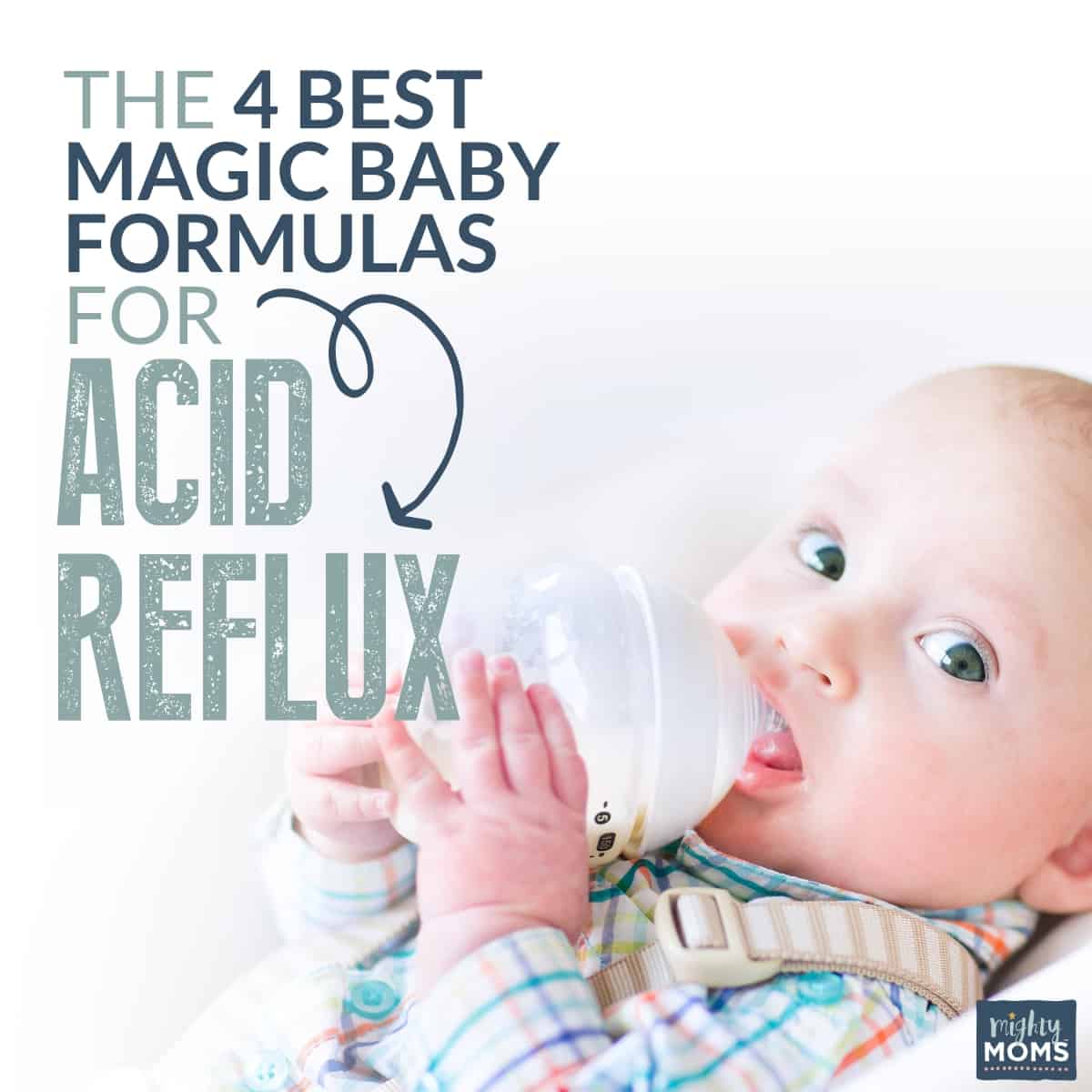In This Article...
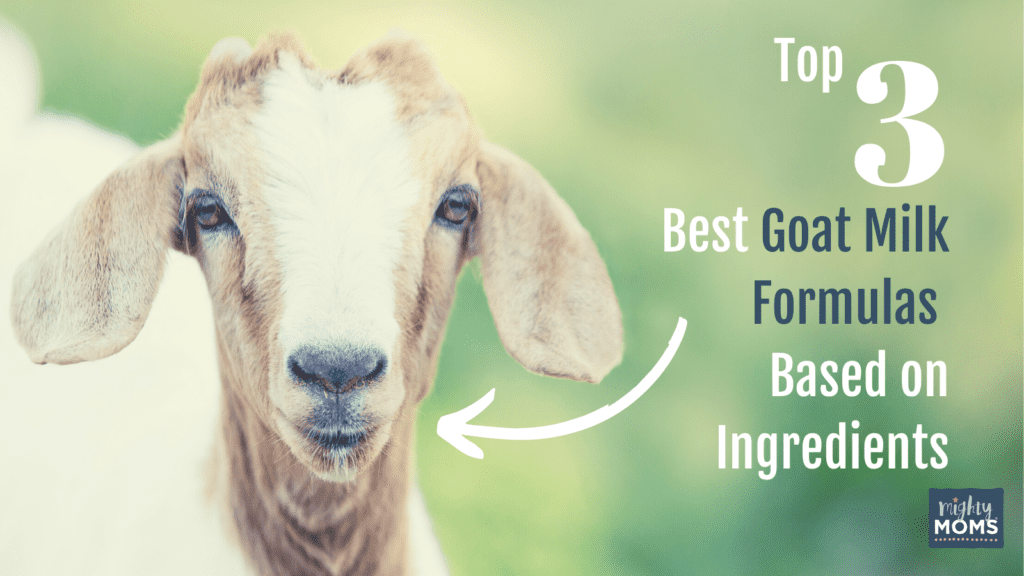
Goat milk formulas are taking over the baby formula world.
More and more parents are reaching out to me, asking if this new concoction could be the answer to all their formula hopes and dreams. They are usually a bit cautious with the question, worried that my response may be a wee bit too hippie dippie for them to process.
So, in an effort to help clear the air on the major differences between goat’s milk formula and cow’s milk formulas, I decided to lump all those cautious questions into one long post.
If you’re already a believer though, and just want to skip to the recommendations, here’s a summary of the top 3 goat milk formulas, based on the research I’ve done.
- Best Organic Goat Milk Infant Formula: Holle Goat Milk Formula
- Best Goats Milk Formula for Newborns: Kendamil Goat Milk Formula
- Best Goat’s Milk Formula for Infants on Solids: Kabrita Goat Milk Formula (Click the link for a free sample)
- Best Goat Milk Formula for Toddlers: Kabrita Goat Milk Formula (Click link for a free sample)
It goes without saying (I’m going to say it anyway), but you should run your feeding questions by your doctor. I’m NOT a doctor. Every baby is different, and your doctor and you will know your baby best.
But First…Understanding the Gut
A lot of this article isn’t going to make sense if you don’t first understand the three most common terms in regards to milk and the gut. So let me start there.
What is Cow Milk Sensitivity (CMS)?
Cow Milk Sensitivity (or CMS) affects 30-50% of all children. An easy way to gauge whether your child is struggling with digesting cow’s milk-based formulas is to check out this list of CMS symptoms:
- Bloating
- Gas
- Constipation
- Diarrhea
- Respiratory Congestion
- Eczema
Studies have shown that goat milk formula can be a good alternative to breastmilk for babies who struggle with cow milk sensitivity. So if these symptoms look familiar, keep reading.
What is a Cow Milk Protein Allergy (CMPA)?
Contrary to popular belief, a cow milk protein allergy is relatively rare in small children: only 2-3% of all children under the age of one. That decreases as children get older, occurring in less than 1% of children over 6.
For more information on this condition, let me refer you to the GIKids.org. They have the best and most up-to-date information.
Goat milk baby formula is not an appropriate choice for children with CMPA. Yes, the milk powder is different, but the protein structures of the milks are too similar to make it an effective alternative. If your child has CMPA, your doctor is more likely to recommend a hypoallergenic formula like one of these.
What is Lactose Intolerance?
Unlike CMPA, which is an allergic reaction to the protein, Lactose Intolerance means the body lacks enough of the enzyme (called lactase) to break down the sugar lactose. (Seriously? We couldn’t name the enzyme something else???)
It is even more uncommon for babies to have lactose intolerance than it is for them to have CMPA. Lactose intolerance usually develops after the age of 3. For more information on this condition, read this.
Like those children who have CMPA, a goat milk formula would not be a good choice for a baby who has been diagnosed as lactose intolerant.
Summarizing Your Child’s Relationship with Dairy
In regards to nutrition, several studies (like this one) have shown that babies who consume goat milk formula grow up just as healthy as those who consume cow’s milk-based formula.
The real difference between the two lies in which is closer to breast milk (goat milk formula, keep reading) and whether your baby shows signs of being sensitive to cow’s milk.
Goat Milk Formula vs. Cow Milk Formula
Okay, let’s get into the nitty gritty. I may get a little “scientific” with you, but I’m trusting that you can handle it. After all, isn’t that why you’re here? 🙂
Benefit #1: Goat Milk Formula Tastes Better
Okay, I get it. Taste is relative. One man’s death-by-chocolate is another man’s brussels sprouts. (I believe that in principle, but my taste buds struggle to agree.)
However, many parents have told me their baby/toddler prefers the taste of goat milk formulas over the standard fare.
Goat milk is traditionally sweeter than regular formula, and has more of a…what’s the word… tang flavor. #scientific
If your child has been used to drinking regular formula, taking the switch slowly (following the directions at the end of this post) will be vital in helping her adjust to the taste.
Benefit #2: Goats Milk Formula is Closer to Breastmilk
I know…that’s quite a claim. Fortunately, I’ve got a ton of research to back this up. (Check out the citations at the bottom of this article for more.)
It Has More Oligosaccarides: Giving Baby Softer Stools
What are Oligo….whatever that word is?
In human milk, olgio…olgo… *cut and paste* oligosaccharides work as prebiotics, immune modulators, and other goodies that help with a healthy gut.
In the colon, these important *cut and paste* oligosaccharides feed the healthy bacteria in your gut (prebiotics.) Pro-biotics are the name for that healthy bacteria, while Pre-biotics are the food sources that keep them happy.
The more *cut and paste* oligosaccharides in the gut, the happier that gut is. The happier the gut, the healthier the baby.
To quote an important study…
Infant formulas nowadays often contain prebiotics but lack the specific functions of human milk oligosaccharides (hMOS). Milk from domesticated animals (i.e. cows) also contains milk oligosaccharides but at much lower levels and with less diversity. Goat milk contains significantly more oligosaccharides than cow or sheep milk…
NIH.gov
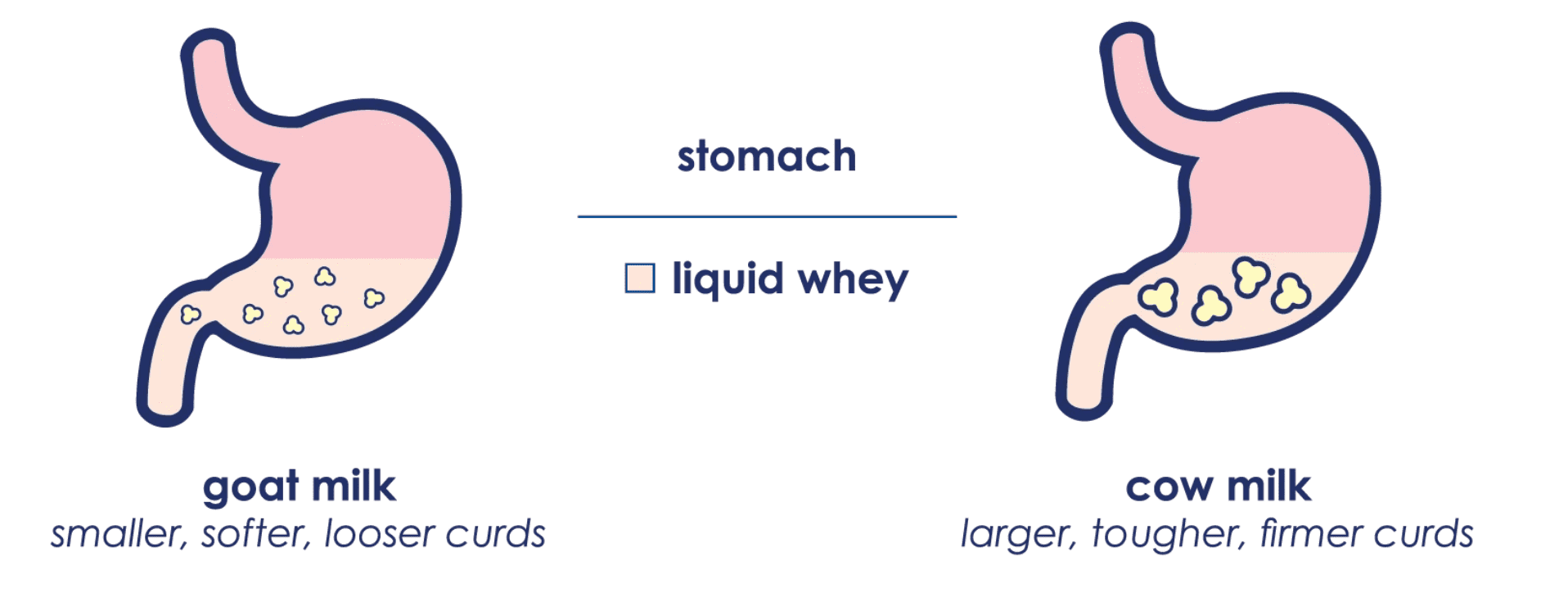
Casein Protein & Whey Protein in Infant Nutrition
When it comes to comparing goat’s milk and cow’s milk, it all comes down to protein structures.
Breast milk is 60% whey protein and 40% casein protein. On their own, cow and goat’s milk contain more casein than whey. (20% whey and 80% casein).
Because of this, most formulas will add whey to try to reach that 60/40 ratio that breast milk contains. Most goat milk formulas will add additional goat whey, which is much easier for babies to digest than cow’s whey.
It’s like the difference between cottage cheese and a block of cheddar. Which would break down in acid faster? Yep. The goat milk curdles in the stomach a lot like cottage cheese in your fridge, where cow’s milk curdles into a tight ball in the tummy.
Goat milk protein is associated with stool characteristics that resemble those of infants fed breast milk.
NDNR.com
That helps explain why goat milk formula is so effective in helping babies with cow milk sensitivities. In this arena, goat milk formula is closer to human milk.
Benefit #3: Goat’s Milk Formula Helps with Eczema
In this study, researchers found that after switching eczema-suffering toddlers from cows milk formula to goats milk formula, the toddlers experienced significant improvement of their eczema.
Check out my article These Simple Toddler Eczema Treatments Will Surprise You for more information on the link between eczema and goat milk.
Understanding Goat Milk Formula Ingredients
First, let me explain the difference between FDA-Approved and non-FDA approved baby formulas. (Hang with me, it will make sense in a minute.)
Is Goat Milk Formula FDA Approved?
Yes, and no.
Some goat milk formulas have been approved by the Food and Drug Administration. (I’m looking at you Kabrita!)
Most have not. That’s because they are manufactured in Europe, which has a different set of standards.
Don’t Let the Words Scare You: Long Labels are Good
Before you get all skeptical on me, let me remind you how complex breastmilk is.
One myth about baby formulas is that we (as consumers) should be able to understand everything on the label.
That might work if you live in Europe, but it won’t fly in the United States. That’s because the FDA requires extremely specific things to be on the label.
You’ve heard of Vitamin B12, right? But have you heard of methylcobalamin? Cyanocobalamin?
No?
Both of those are a type of B12. And the FDA wants to know exactly which type is inside that can. Here’s a picture of the back of a Kabrita can of goats milk formula, so you can get an idea of what I’m talking about.
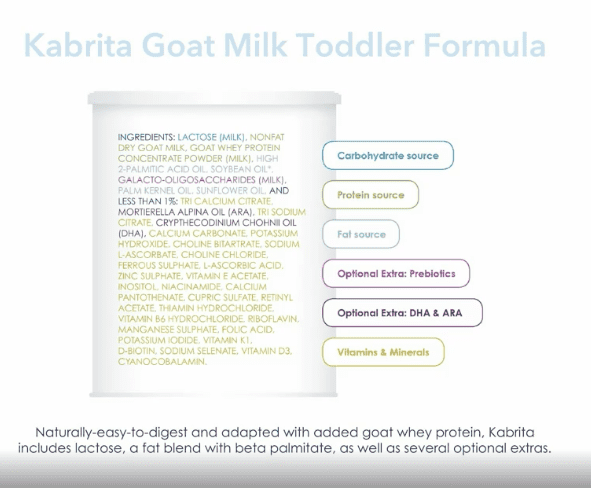
Still doubt me? Let’s take a little quiz.
Look at the photo below and see if you can guess what item it’s describing, in FDA-approved language.
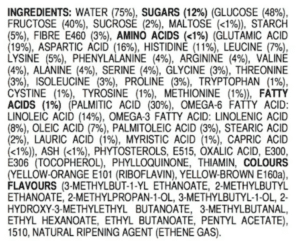
Spoiler Alert: It’s a banana.
5 Best Goat Milk Formulas
Okay, so now we get to the part in the show that you’re really interested in.
Which goat milk formula is the best? To help with that, I’ve divided it into four categories:
- The Best Organic
- The Best for Newborns (0-6 months)
- The Best for Babies on Solid Foods (6-12 months)
- The Best for Toddlers (>1 year)
Here we go!
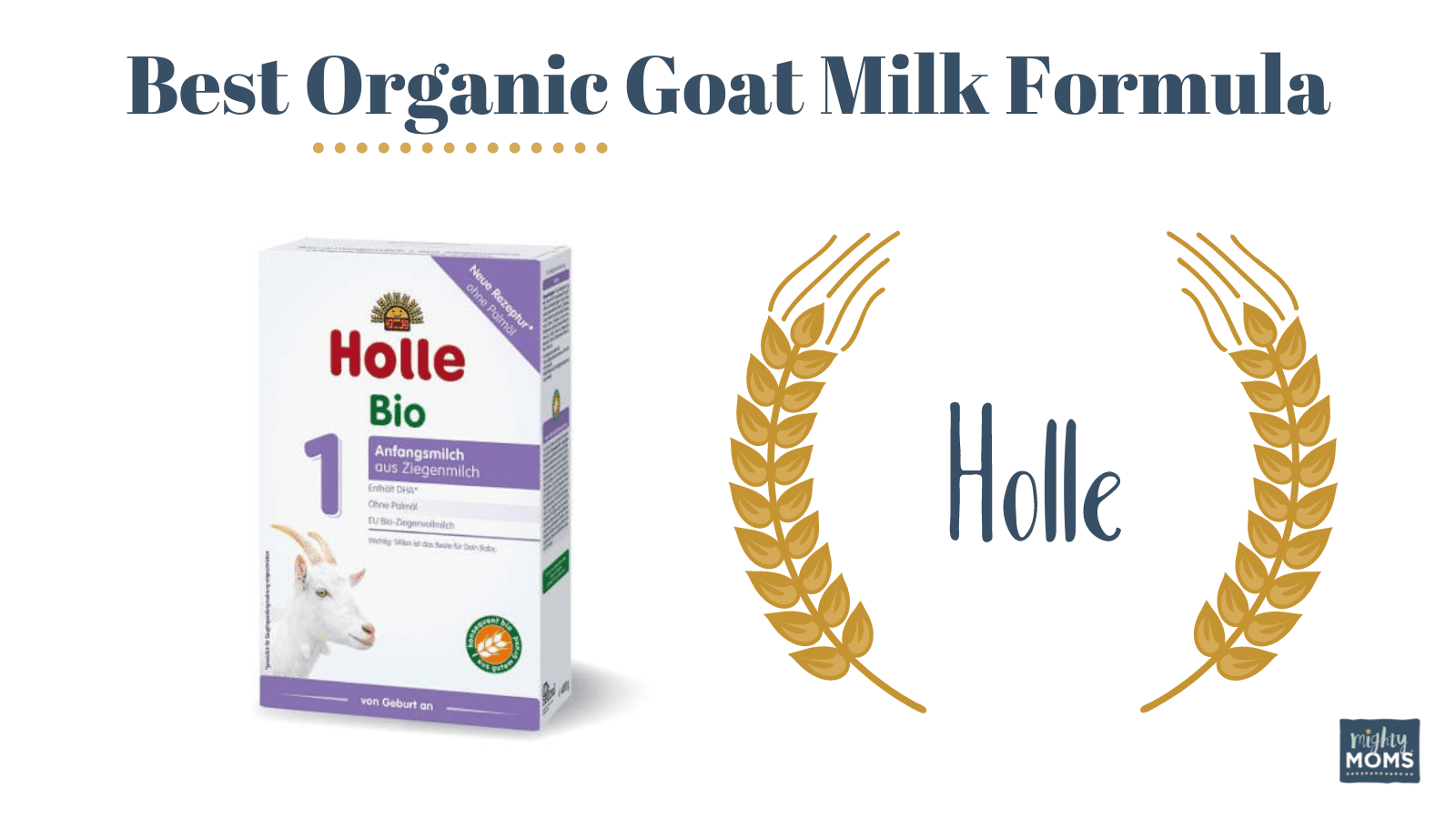
Best Organic Goat Milk Formula: Holle
When it comes to organic standards, nothing out-does the Europeans. Holle, as a company, has been around more than 80 years, so they have more than proven themselves as an excellent source for organic goat milk formula.
How to Understand the Box (It’s in German)
For American parents, the hardest obstacle is the language barrier. The box is written in German and words like “anfangsmilch” and “ziegenmilch” can seem scary, so here’s a quick tutorial in German:
- Anfangsmilch – means “starting milk”
- Ziegenmilch – means “goat milk”
- Nach dem vorbild der natur – means “along the lines of nature”
- von Geburt am – means “from birth on”
- gut sattigend – means “good saturation”
There are instructions in the box in English, so don’t panic. You may want to keep in mind, however, that the expiration date is written in the EU version of dd/mm/yyyy and not the traditional American mm/dd/yyyy format. 🙂
Love this organic formula, my kids have cow milk sensitivities and this was a great alternative for them. I’ve ordered from this company for several years for all four of my children and the customer service has always been top notch.
Elizabeth T.
Where to Buy Holle Organic Goat Milk Formula
This can get a little tricky. Since these formulas are not FDA-approved, purchasing organic European formulas from a store in the United States is illegal.
There are a ton of shops online selling organic European formula illegally and the FDA has started to crack down hard on them, raiding the stores and shutting them down. If that happens, you will find yourself without any organic formula, and *gulp* possibly without a refund.
Avoid that headache by making sure the place you are ordering from ships from Europe and NOT from the United States. (And, to save money, buy your organic European formula bulk!)
I’ve been working with this company in Germany for years. They have been great with all my readers and I feel extremely confident recommending them. You will get a great product and even better service.
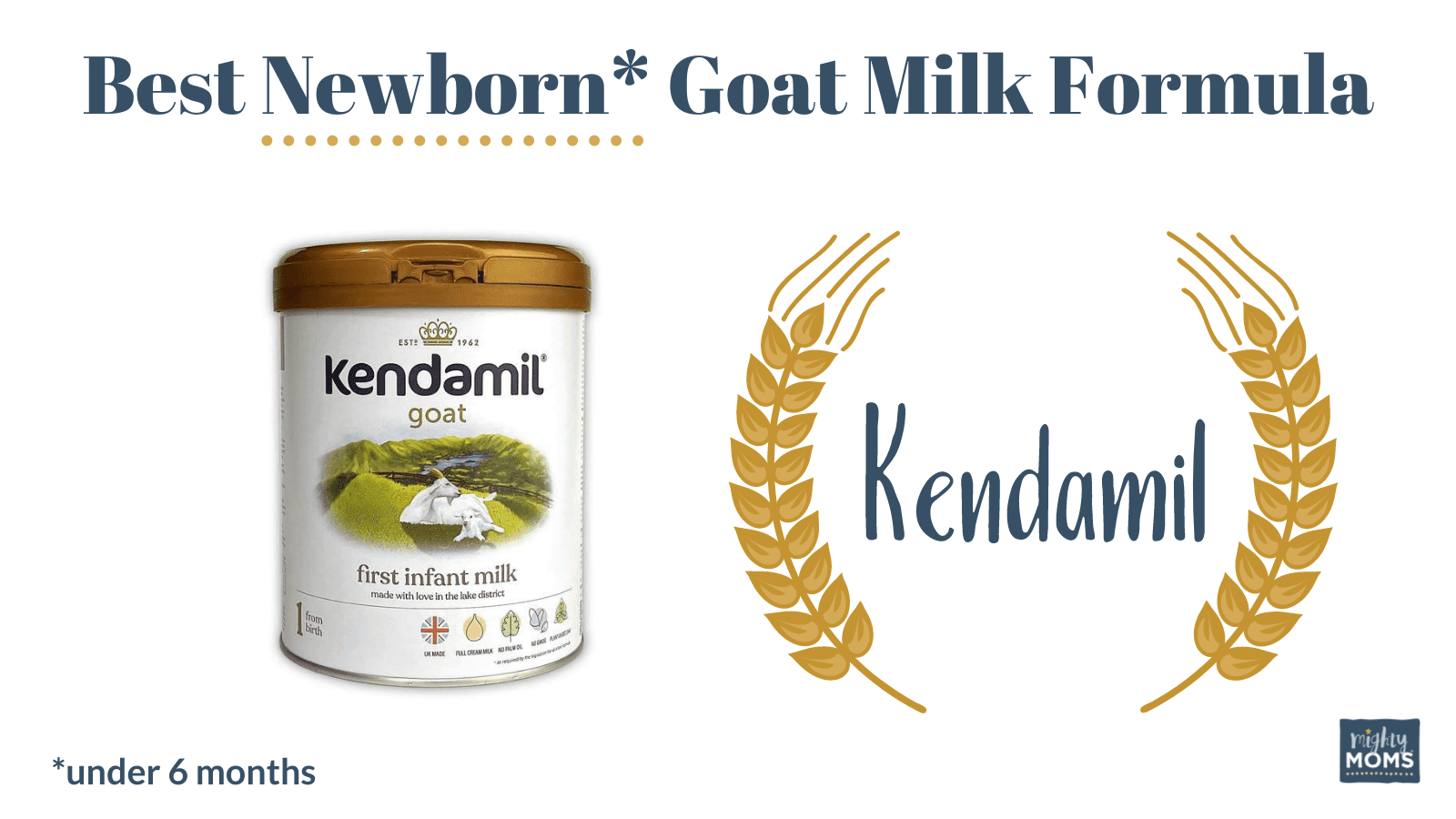
Best Goat Milk Formula for Newborns: Kendamil
My top recommendation for newborns is Kendamil, which is manufactured in (according to their website) “the English Lake District and proudly source our ingredients from family farms across Cumbria, Somerset, and Yorkshire”.
Yes. I’m picturing those romantic hills too. Mr. Darcy and his goats.
All their farms are “Red Tractor Certified” which means they have been inspected to make sure the formula is responsibly sourced, safely produced, and from animals that have been well cared for. (Each goat has a name, not a number.)
Another good distinction for Kendamil goat formula is that they get their DHA vitamin from plants, not fish (which is the usual cheaper alternative). This is part of their commitment for sustainable seas.
This formula is delicious! It tastes like creamy, sweet milk, not manufactured formula. It’s delicious and I appreciate the healthy ingredients as well as the intense care put into making it. Thank you, for what I consider to be, the best formula!
Christina
Here are a few other bragging points about Kendamil goats milk formula.
- They use a unique whole milk recipe that provides a more naturally-derived fat source, reducing the amount of vegetable oils.
- They do not use palm oil, fish oil, soya, or GMOs.
- The whole milk also provides a natural source of Milk Fat Globule Membrane that has been identified within breastmilk.
- It uses A2 goat milk, which has been proven to be easier to digest. (More info on that.)
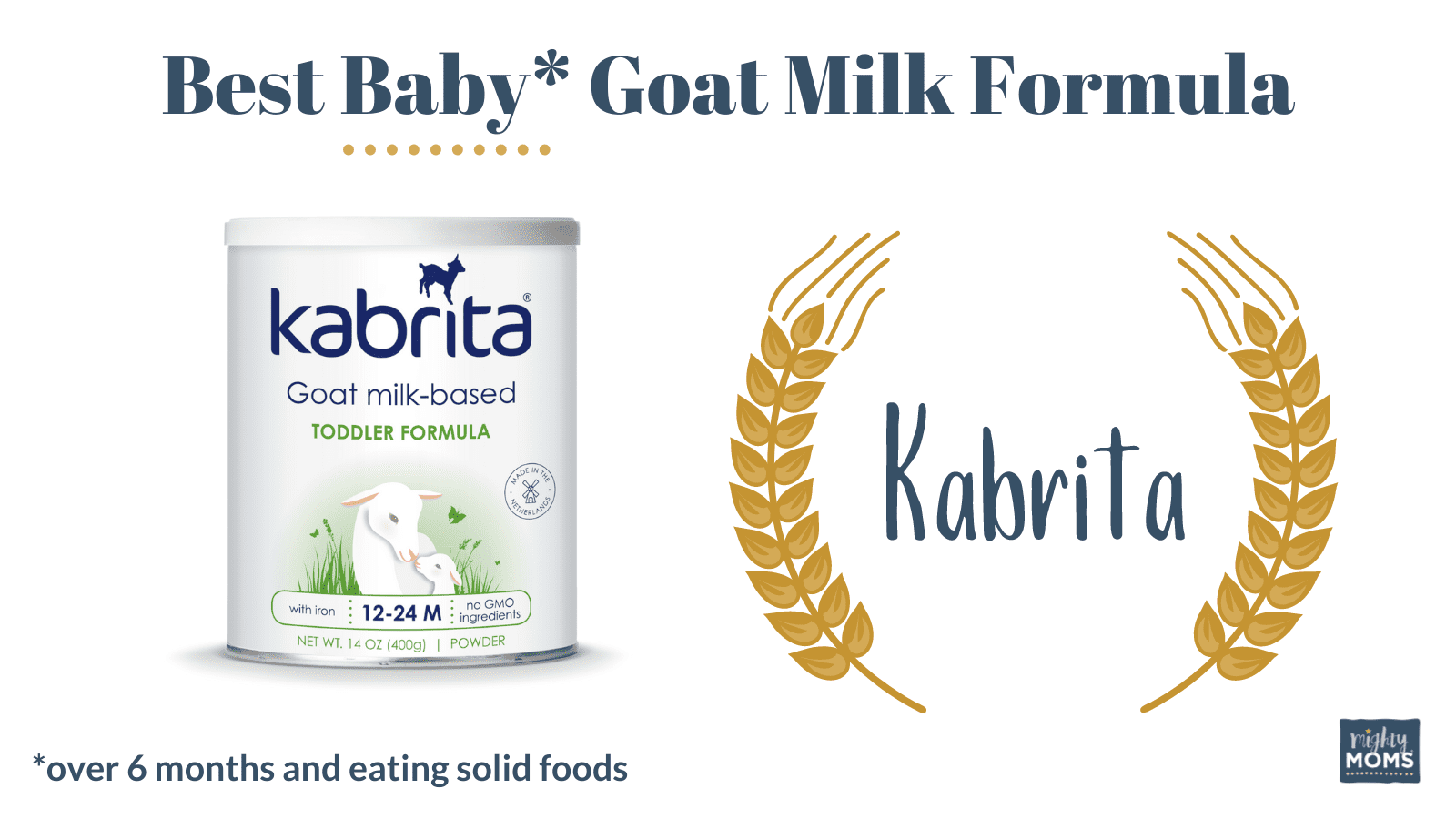
Best Goat Milk Formula for Babies Eating Solids: Kabrita
Yes, I can read. I know the can says “toddler formula” on it, and yet, here I am, declaring it as the best goat milk formula for babies over 6 months old.
Did you see the asterisk though? I’ve got a disclaimer: For babies who have started solids.
I’ve spent years researching formula (since I first launched the website in 2007) and Kabrita is the brand I’ve settled on. The reason it is labeled “Toddler Formula” is because they are in the middle of filing the paperwork with the FDA to get it approved as an infant formula. (Same powdery goodness, just a different word on the front.)
Covid has slowed that process down even slower. It takes years and years for products to get through approval, which is why many European baby formulas don’t even try.
I’ve heard from numerous physicians that the formula is appropriate for babies over 6 months who are eating solid foods. That said, if your doctor says otherwise, go with Holle or Kendamil instead. They are excellent substitutes.
Kabrita has been an answered prayer for us. All other formulas constipated our son and hurt his tummy. Kabrita has kept him regular and although he still spits up, he doesn’t struggle with tummy aches as much and isn’t as colicky. Great product!
Lisa G.
What You Need to Know About Kabrita’s Oils
If you look at the label for Kabrita’s toddler goat milk formula you’ll see the phrase “High 2-Palmitic Acid Oil”
Oh no! I hear you screaming. That sounds like Palm Oil!
Don’t panic! About 20-25% of the fat in human breast milk is palmitic acid, which is crucial in fat, mineral, and vitamin absorption and healthy intestines. Of that amount, 70% is in the beta palmitate form. This has been shown to increase the absorption of both calcium and fatty acids.
After that phrase is listed “Soybean Oil”. Oh no! Let me pull back on those panic horses again. 90% of the soybean oil in America is genetically modified, but the soybean oil in Kabrita doesn’t come from America. It comes from Europe, where strict agricultural guidelines govern the use of GMOs, antibiotics, pesticides, and growth hormones.
Also, in case you’re wondering, the oil is non-allergenic (since there’s no protein). Most people with soybean allergies can safely eat soybean oil.
Kabrita mixes these oils in a OPO format (most formulas use the POP format). But that’s a bit too complex for me to get into here. If that interests you, this is where you want to go. It will walk you through all the ins and outs of fatty acids.
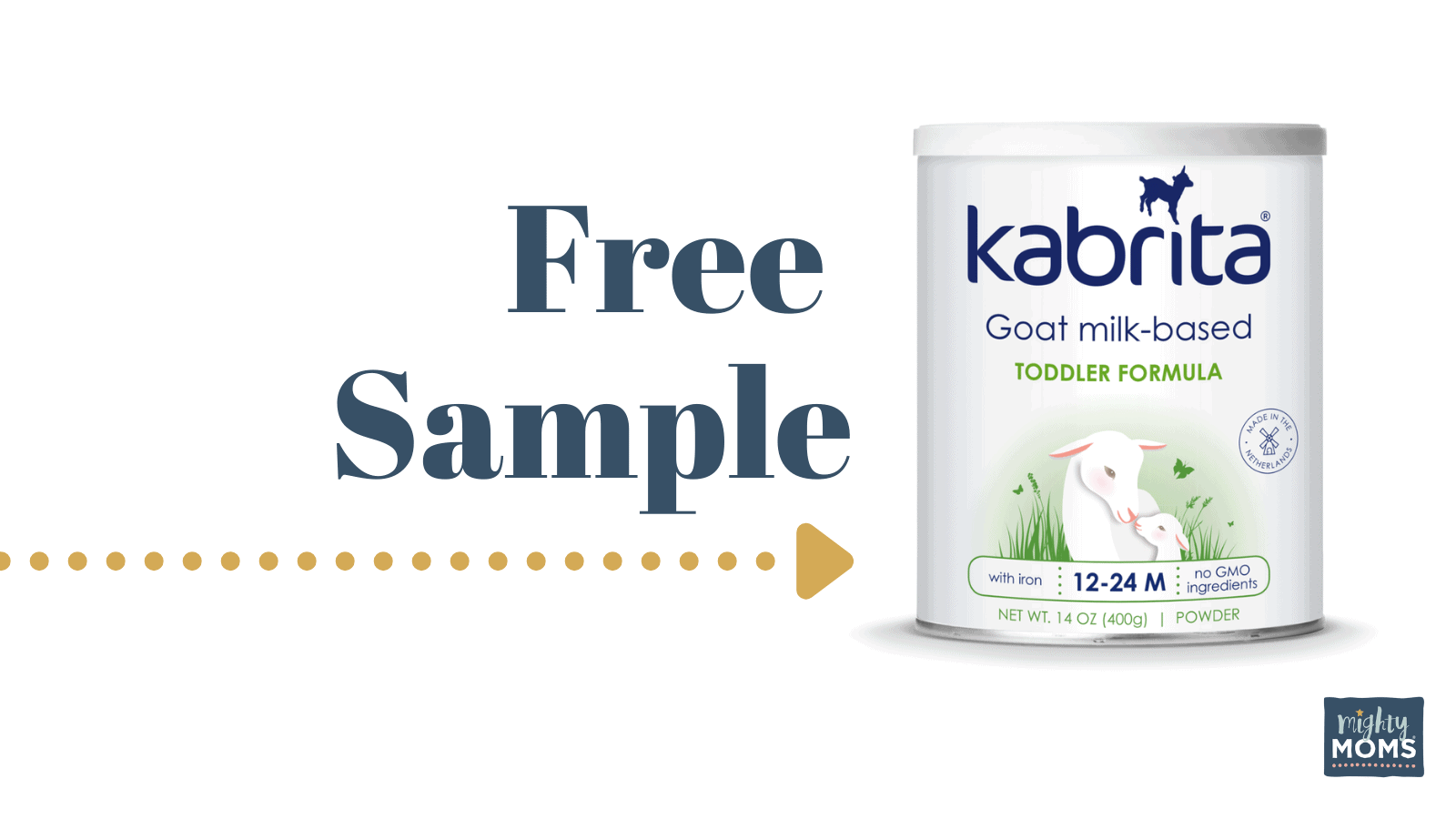
Kabrita is Giving Parents a Free Sample of Their Goat Milk Formula
Yes, you can try-before-you-buy! Go here and Kabrita will send you…
- Three 5.3 oz cartons of Goat Milk Toddler Formula (24 servings)
- One .53 oz bag of Snack Puffs with Goat Cheese
- $14 worth of coupons
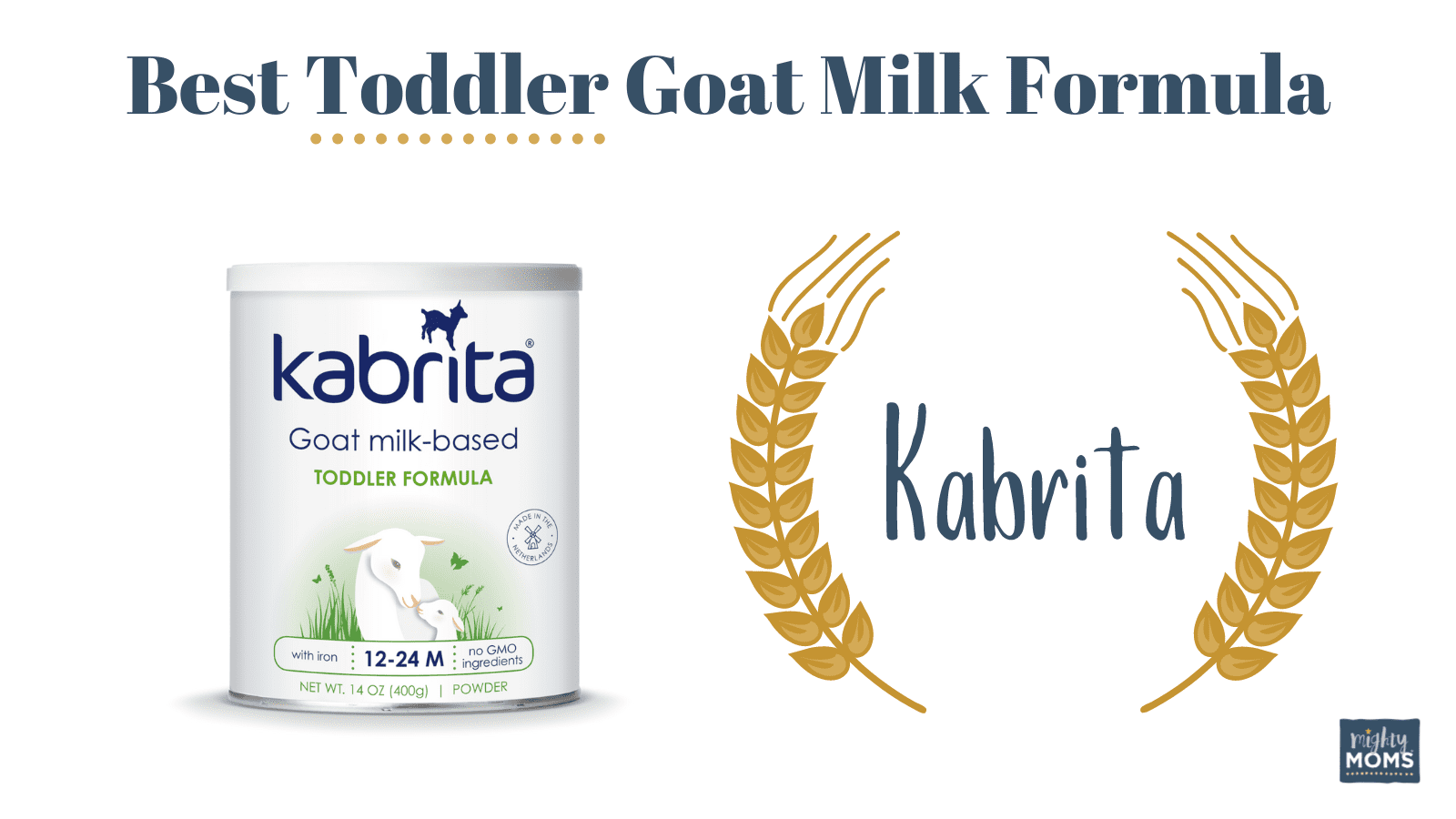
Best Goat Milk Formula for Toddlers: Kabrita
Yep. I’m repeating myself. But that shouldn’t be a surprise.
After all, if I’m going to declare Kabrita as the best goat milk formula for babies who are eating solids, why wouldn’t I be consistent and say it’s the best goat milk formula for toddlers too?
Why Not Give Toddlers Regular Goat Milk Instead of Formula?
That’s a question that pops up a lot. Why buy a more expensive formula when you can pour a glass of plain-old goat’s milk?
I’ll tell you. (You knew I would!)
- Regular goat milk is extremely high in protein. So high, in fact, that it can take a toll on those tiny kidneys. The formula, however, has been manipulated to avoid that complication.
- Plain goat’s milk is low on folic acid, vitamin D, and iron. These are essential nutrients for a toddler’s healthy growth and development. They are also all present in Kabrita’s free sample. Your little one needs those essential fatty acids!
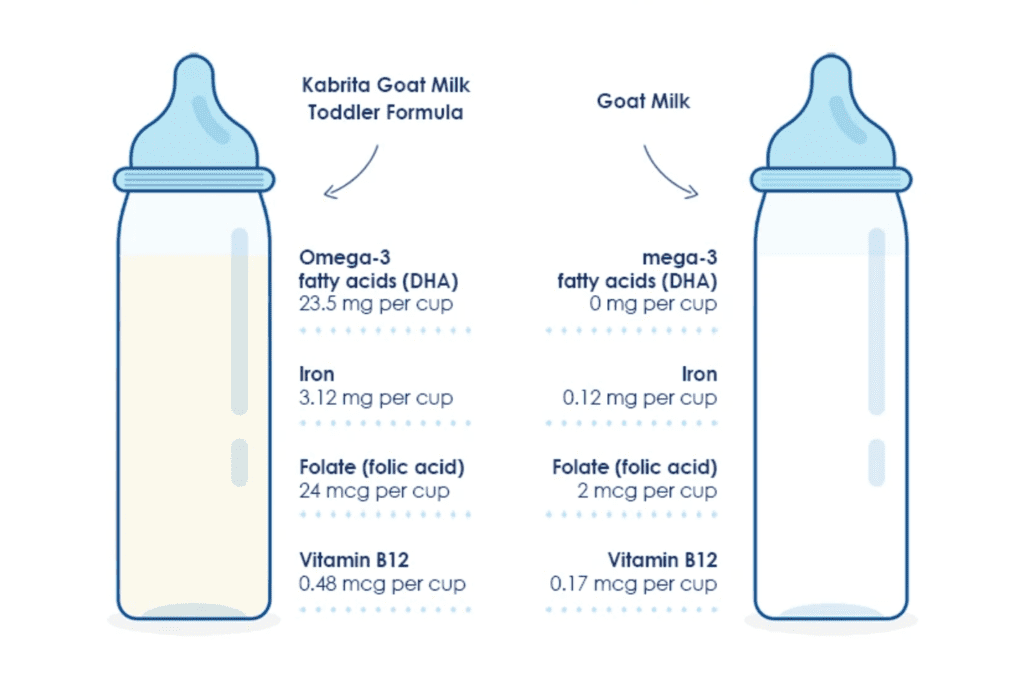
Should You Give Your Toddler a Cup of Nut Milk Instead?
Okay, if regular goat milk isn’t ticking all the boxes, and that cow’s milk sensitivity is still wreaking havoc, why not pour out a sippy cup of nut milk instead?
Here’s why: It is recommended that toddlers aged 1-3 years get at least 13 g of protein every day. Kabrita’s goat milk formula provides 5 grames of protein per 8 oz (1 cup). Compare that to 1 gram or less of protein in a cup of whole nut milks.
Besides the protein problem, nut milks are also low in vitamin K, B vitamins, folic acid, phosphorus, zinc, manganese, copper, and selenium.
So resist the temptation to give your growing toddler plain milk and reach for the free sample of goat milk formula instead. Your child’s developing mind will thank you for it. Those are vitamins your toddler desperately needs!
How to Switch Your Baby to Goat’s Milk Formula
Once you’ve picked up your free sample or received your online order, it’s time to gently introduce this new elixir. As I’ve mentioned before, the best way to make sure your tot’s tummy doesn’t go all rogue during this transition is to do it slowly.
Here’s a daily switching schedule for you to follow:
- Day 1-2: Mix 20% goat milk formula with 80% breastmilk, or your regular formula.
- Day 3-4: Mix 50% goat milk formula and 50% breastmilk or your regular formula.
- Day 5-6: Mix 80% goat milk formula with 20% breastmilk or your regular formula.
- Day 7 and Beyond: 100% goat milk formula!
This is a nice and slow way to help your child’s tummy get used to the adjustment in proteins and carbs as you switch from the cow milk infant formula family to the goat milk formula family.
It’s amazing what a huge difference a simple formula shift can have on your baby’s overall health and happiness. Of course, I wouldn’t just assume you’d take my word for it!
Read the switching stories of other moms, just like you, and how goat milk formula made a huge impact on their child’s wellbeing.
Goat Milk Formula:
Not Just for Crunchy Moms!
See? Goat milk formula isn’t just for hippie crunchy moms!
It’s for the mom struggling with a fussy gassy baby.
It’s for the child with boulders in his diaper.
Goat milk formula is for those itchy red bumps leaving your child swollen and scratchy.
It’s for the mom who feels uneasy about the standard cow milk formula, stressed about the warnings about soy formula, and just wants something that will provide good nutrition without the extra side effects.
In other words… goat milk formula is very likely for you. 🙂
We ♥ honesty! This post contains affiliate links that provide extra money for our mutual coffee habits addictions. Click here to learn more. As an Amazon Associate I earn from qualifying purchases.
Citations
Scientific Opinion on the Suitability of Goat Milk Protein as a source of Protein in Infant Formulae and in Follow-on Formulae. Wiley.com
Comparison of the Compositions of the Stool Microbiotas of Infants Fed Goat Milk Formula, Cow Milk-Based Formula, or Breast Milk. Asm.org
Nutritional Adequacy of Goat Milk Infant Formulas for Term Infants: A Double-Blind Randomized Controlled Trial. Cambridge.org
Composition of the Non-Protein Nitrogen Fraction of Goat Whole Milk Powder and Goat Milk-based Infant and Follow-on Formulae. TandFOnline.com
Comparison of Growth and Nutritional Status in Infants Receiving Goat Milk-Based Formula and Cow Milk-Based Formula: a Randomized, Double-Blind Study. TandFOnline.com
Alternatives to Breastfeeding: The Use of Goats’ Milk in Infant Formula. MagOnlineLibrary.com
Atopic Dermatitis & Babies: Two Cases Substituting Goat Milk Formula for Cow’s Milk Formula. NDNR.com
Why Goat Milk Formula? KabritaUSA.com
Cow’s Milk Protein Allergy. GIKids.org
Lactose Intolerance or Milk Allergy: What’s the Difference? EverydayHealth.com
Oligosaccharides in Goats’ Milk-Based Infant Formula and Their Prebiotic and Anti-Infection Properties. NIH.gov
Goat Milk Oligosaccharides: Their Diversity, Quantity, and Functional Properties in Comparison to Human Milk Oligosaccharides. NIH.gov

